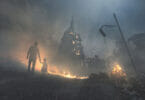The following report is from Survival.News:
First, you need to learn about the fire triangle, which details a fire’s requirements: oxygen, an ignition source and fuel. Oxygen is readily available, but having too much or too little of it can affect how quickly you build a fire.
Your ignition source is anything that provides heat to combust materials. This can come from a lighter and matches, friction, or a chemical reaction.
Fuel starts your firebase and keeps it going. Fuel is broken down into three categories:
- Tinder is any dry material with a lot of surface area that burns easily. You can use materials like bird’s nests, cotton balls, dry grass, the tops of dried weeds, tree bark, twigs and wood dust. You can also use man-made tinder, like dryer lint.
- Kindling is placed on top of the burning tinder. Since tinder doesn’t burn for a long time, you need small pieces of kindling that will catch fire quickly. Kindling shouldn’t be thicker than your fingers, so look for dried twigs.
- Fuel can be any type of wood larger than your kindling, like branches and logs.
Once you have everything you need, prepare to start a fire. Get plenty of tinder and keep the kindling nearby.
After you ignite the tinder, add the kindling slowly so you don’t snuff out the fire. When you have a hot base of embers, carefully place the fuel around and above the fire.
5 Types of campfires
Below are five types of campfires that you can use if you need to cook or stay warm while outdoors.
Dakota hole fire
Build a Dakota hole fire if you want to conceal the light of your fire or protect it from the wind. To build this campfire, you’ll need a digging tool.
Steps:
- Dig a hole that’s about one foot wide by one foot deep.
- Inside the hole, dig a tunnel that’s at least one foot long, with the end of the tunnel connecting to the surface.
- Place the tinder and kindling in the large hole and start a fire. The tunnel will provide airflow to the base of the fire. Since the fire is burning under the surface of the ground it will be contained and hidden from unwanted pursuers.
Keyhole fire
The fire pit of a keyhole fire looks like an old-fashioned keyhole.
Steps:
- One side of the pit needs to be in the shape of a circle. On one side of the circle, form a connected area in the shape of a rectangle. This design makes it easier to regulate the temperature of the fire, like if you were about to cook something.
- Light a fire in the middle of the circle.
- When you establish a good base of hot embers, rake the coals to the side and into the rectangular section. Wood will continue to burn in the main section of the pit and you can use the coals to the side for cooking. (Related: Fire is a versatile survival asset – Here’s a list of things you can cook over it.)
Log cabin fire
The frame of a log cabin fire is constructed from larger pieces of wood and assembled like a log cabin.
Steps:
- Place two pieces of wood into the fire pit that are parallel to one another. Leave enough space in between for the fire.
- Place two similar-sized pieces of wood on top of the first two so that they’re perpendicular to the base. Repeat this process until the pile of wood is big enough for your needs.
- Place the tinder and kindling in the middle and start a fire.
Pyramid fire
A lot of the wood for this design is pre-stacked so you can use this frame if you don’t want to constantly add wood to your campfire.
Steps:
- Make a pile using large pieces of wood then stack smaller and smaller pieces upward to form a pyramid-shaped pile. Place the ascending layer opposite of the previous layer.
- You can light a pyramid fire from the bottom but the tinder and kindling are usually lit and placed on top.
Upside down fire
As the name implies, an upside-down fire is the reverse setup of most fires.
Steps:
- Make your base by placing several large pieces of wood parallel and butting up next to one another on the ground.
- Place slightly smaller pieces of wood on top of and perpendicular to the base. Keep stacking smaller and smaller layers of wood upward until the woodpile is as tall as you need it.
- Place the tinder and kindling on top and start the fire. Feed the fire with kindling until it starts to burn downward.
Always be mindful of your surroundings when building a campfire. Never start a fire you can’t control and extinguish it properly when you’re done with it.
AUTHOR COMMENTARY
With all that is coming down the pike in this country (and around the world), I am going to try and make a more concerted effort to post some practical and informative advice that is good, not just for survivalism, but for everyday use. When the grid goes down in the not too distant future, no-brainer skills that man has known for thousands of years (and forgotten in this modern age) will come in VERY handy. Fire-making is the one of the most basic but absolutely critical things required to eat, stay warm, boil water, and so on.
A Handful Of Helpful Medicinal Plants In God’s Creation
The WinePress needs your support! If God has laid it on your heart to want to contribute, please prayerfully consider donating to this ministry. If you cannot gift a monetary donation, then please donate your fervent prayers to keep this ministry going! Thank you and may God bless you.








Very handy and important information Jacob. So much I don’t know and I want to learn it so badly like basic survival and tools as well and hunting and fishing for food. Pray that king James Bible believers will be sent to me in this satanic catholic pentecostal church building corrupt city of Laredo that I live in.
Survival-Evasion fire: This fire is to provide warmth, cooking needs, and moral while evading the enemy. With a shovel or knife, cut out a thick 1′ x 1′ square of sod, preferably in a secluded area. Build a small fire inside the cutout using small sticks and twigs only, to keep the fire small. If you need to extinguish the fire quickly, place the sod square back into the cutout, smothering the fire and concealing it at the same time.
Thanks for sharing!